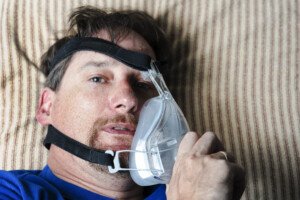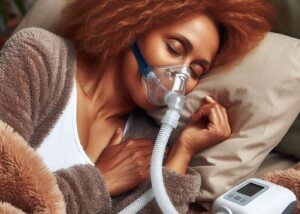
People who find the CPAP device very uncomfortable may end up using it inconsistently and wonder how bad their sleep apnea can still be with this approach.
Some people can’t tolerate sleeping with a mask for a variety of reasons.
• Certainly, such an individual might think that four nights a week of CPAP use is enough to reduce sleep apnea to a non-life-threatening level.
• Or, they may wonder if they could get away with three times a week?
• How about two?
“It’s hard to say, but I’d liken this situation to having another chronic medical problem like hypertension or diabetes,” says Joseph Krainin, MD, board certified in sleep medicine and neurology and founder of the online sleep apnea clinic Singular Sleep.
“If you only take your beta blocker or metformin sporadically, you won’t be fully protected from the long-term negative health consequences of the underlying disorder,” continues Dr. Krainin.
“CPAP clearly shows a ‘dose response’ effect, i.e., the more you use it the better health outcomes you get up.”
A study by Weaver et al in the journal Sleep (April 1997) reveals a dose response effect.
The nightly CPAP use of 32 patients was monitored for nine weeks via a microprocessor inside the device.
Half the people were consistent with their CPAP use, while the others were “intermittent users” whose nightly use averaged 3.45 hours (compared to the more compliant group’s average of 6.22).
Nine weeks aren’t long enough to really know just how detrimental intermittent use of a much needed CPAP machine is for someone diagnosed with obstructive sleep apnea.
However, the paper explains that the intermittent CPAP users reported “significantly greater OSA symptoms post-treatment, suggesting that they continued to experience sleep disordered breathing.”
The reported symptoms were:
• Snoring
• Snorting
• Apnea (cessation of breathing)
There have never been studies investigating the reduction of efficacy relating to varying degrees of intermittent CPAP use.
For example, take 100 patients with newly diagnosed obstructive sleep apnea.
• Re-evaluate their symptoms and health after four months of 100 percent consistency. (Consistency would be confirmed with a microprocessor).
• For the next 120 days have them use the device only six days a week, then re-evaluate.
• For the next 120 days it’s five days per week, and so on, till you’re down to just once a week CPAP use over a four month period.
• Number of hours spent each night using the machine would need to be factored in. And this alone would make the investigation quite sticky.
For instance, at what point would a night of CPAP use no longer be considered valid? Under five hours of use? Under four?
• Hopefully in such a long-term experiment, the participants would honestly use the CPAP machine for at least six hours.
• The ideal study subject, then, would be someone who’s not prone to overnight interruptions that could reduce total sleeping time and/or discourage putting the CPAP machine back on.
• This would include parents of babies and toddlers; people who are caregivers to an elderly or disabled person in the home who needs overnight assistance; and people with medical conditions that can disrupt sleep.
• And then there’s the issue of health detriments to the subjects who’d experience a resurgence of daytime health issues as their CPAP use during the study period declined.
• This would have to be an extraordinarily controlled study involving otherwise healthy people (e.g., no diabetes, obesity, asthma, congestive heart failure), ideally with the participants sleeping overnight in a lab throughout the entire course.
You can see with all of these bullet points how enormously difficult it would be to pull off such a study while keeping any limitations very minimized.
Final Thoughts on CPAP Use
If you’ve been diagnosed with sleep apnea, just use the CPAP machine every night; do not fall into the trap of becoming inconsistent.
While six days a week, even five days a week, of CPAP use would prove beneficial when compared to three nights a week and especially no use at all … at least with 100 percent consistent use, you won’t have to keep wondering.
Another way to look at this is to compute the number of days in a year without CPAP use if you were to use the machine only five days a week.
That would be 104 nights per year during which your brain is deprived of adequate oxygen.
Now multiply that by five years: That’s 520 nights your brain is without sufficient oxygen. At four nights a week of CPAP use it jumps to 780.
A person with sleep apnea must use a CPAP machine with 100 percent consistency in the name of preventing life-threatening complications down the road such as stroke, heart attack and crashing a car due to drowsiness. There is no middle ground.
 In 2013 Dr. Krainin was elected a Fellow of the American Academy of Sleep Medicine, an honor reserved for sleep doctors who’ve made significant contributions to the field in education, research and service.
In 2013 Dr. Krainin was elected a Fellow of the American Academy of Sleep Medicine, an honor reserved for sleep doctors who’ve made significant contributions to the field in education, research and service.
 Lorra Garrick has been covering medical, fitness and cybersecurity topics for many years, having written thousands of articles for print magazines and websites, including as a ghostwriter. She’s also a former ACE-certified personal trainer.
Lorra Garrick has been covering medical, fitness and cybersecurity topics for many years, having written thousands of articles for print magazines and websites, including as a ghostwriter. She’s also a former ACE-certified personal trainer.
.









































